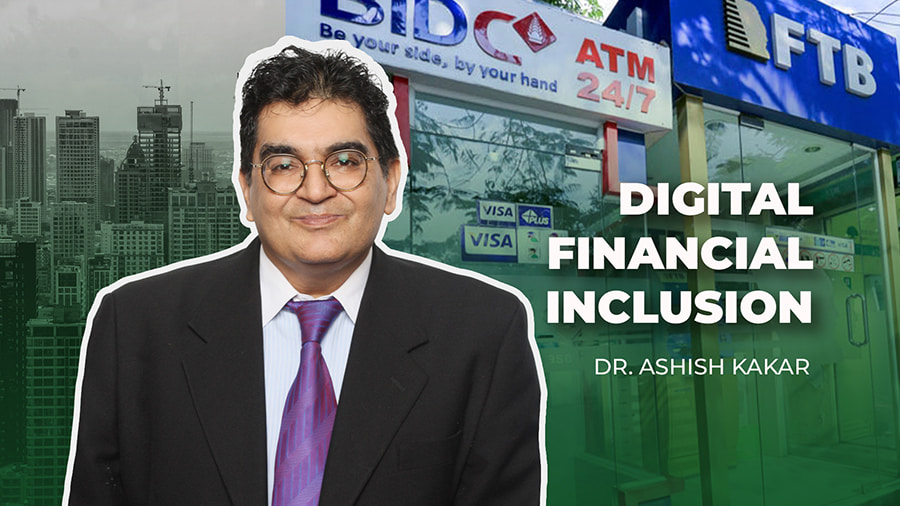OPINION: Gearing For Digital Financial Inclusion – The Next Big Opportunity For Cambodian Banks
Cambodia’s financial inclusion policy is set out in its National Financial Inclusion Strategy 2019-2025, but do structural challenges make this a tall task to achieve? Our guest writer, Dr. Ashish Kakar, weighs in on the subject.
Views and opinions expressed in guest writer opinion pieces are those of the author(s) and do not necessarily reflect the official position(s) of B2B Cambodia.

The challenge in 2024 is emerging from an excessive reliance on microfinance that adds to structural inefficiencies - Cambodia’s microloan portfolio had reached USD $16 billion by Q1 2023 on the back of as much as 20 per cent growth in 2022.
According to the Cambodia Microfinance Association (CMA), by the end of Q3 2023, the sector had a total loan balance exceeding USD $5 billion and more than 1.5 million loan customers. The inefficiencies are further evident from the latest Credit Bureau of Cambodia's data as of Q3 2023; which indicated that the 30 days past due is at 5.8 per cent, which can be interpreted as showing early signs of a credit crisis.
The root cause lies in the consumer's dependence on Cambodia’s microfinance institutions (MFIs) and the financial stress may impact the national inclusion goals of the Kingdom. A credit crisis would challenge financial inclusion as the weaker segments are most affected during the crisis.
Excessive dependence on microfinance is further accelerating this potential crisis. As per figures released by the International Monitory Fund (IMF) in 2023, the cost of microfinance funding has increased significantly post-COVID, leading to the industry resorting to the reportedly unhealthy practice of non-interest-related fees on top of the 18 per cent rate cap and alleged brutal collection strategies as reported by media outlets such as Nikkei Asia, of debtor suicide and young children being forced to join the labour market to alleviate the family debt situation. Financial inclusion needs a different strategy to be effective and sustainable.
In Q1 2023, the Association of Banks in Cambodia (ABC) and the Cambodia Microfinance Association (CMA) announced they would work with the Cambodian government in the fight against informal lenders and unscrupulous practices. As many as five deposit-taking microfinance institutions and more than 80 non-deposit-taking MFIs were operating in Cambodia in 2023.
How Can Cambodian Banks Help Cambodia Achieve Financial Inclusion Goals?
Some segments of the microfinance market could be profitable for banks and, at the same time, help meet the national inclusion goals. As per IMF statistics released in 2021:
- Deposit-taking microfinance companies makeup 60 per cent of the total borrowers.
- 23 per cent of the total value of small corporate and working capital loans.
That is a sizable market share to excite bankers. No wonder some deposit-taking microfinance institutes are like banks and, in some cases, larger than banks. Traditionally, microfinance has been successful in Cambodia as banks could not extend to remote corners of the Kingdom as they didn't have nationwide physical branches. Microfinance institutions, with their presence, offered the only real alternative, though with the dual challenges of high funding and operating costs.
However, reliance only on microfinance loans has also led to a higher risk variance and high-interest rates and high non-interest-related fees resulted from these inefficiencies. In the current inflationary environment, such high rates stress lower-income segments and compromise the inclusion agenda – that is where Cambodian banks must step in. The growth of digital banking in Cambodia is reducing the dependence on physical branches, while other improvements in digital banking, include:
- Cambodia, as per recent reports, has around 68% internet penetration.
- Digital data consolidators such as CamDX and the National Bank of Cambodia’s Bakong have enabled a risk-based scoring model for personal and working capital loans.
- Post office tie-ups act as the cash collection centres - This segment can be operated as a digital microfinance bank, a subsidiary of a larger bank, which has proven successful in other parts of the world such as in Taiwan, Australia in the non-urban centers, and Barclays in India for cash management.
Such arrangements would help achieve multiple goals. For a Cambodian bank, it allows them to access 23 per cent of the lending book currently captured by the deposit-taking microfinance institutions. With the bank's lower funding and operating costs, the efficiency gain can be passed to the consumers as lower interest rates.
As per 2021 IMF statistics, the average interest borne by a bank borrower in Cambodia is 12 per cent compared to over 18 per cent for microfinance lenders. These changes could also improve the stability and resilience of the financial sector. As noted earlier, there is a higher risk variance due to microfinances' dependence on a higher-risk portfolio.
The global financial crisis has taught us that such dependence can cause market turbulence. On the other hand, banks have a mix of low-risk and high-risk portfolios, ensuring better resilience. They would also be less likely to use the strong-arm collection strategies of some microfinance institutions being reported in the media. Of course, lower interest rates and increased digital penetration would help the financial inclusion goals of the Cambodian government in the long run.
About The Author: Dr. Ashish Kakar has over 20 years of financial services experience managing large strategy, business, technology, and transformation regional roles across Asian & European markets. He now leads financial services research for a large consultancy with focus on strategy, risk management, AI, transformation, resiliency, and lending.